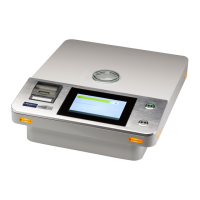Restrictions 6.1.2.
When applying blank subtraction, the same blank must be used consistently. Do 6.1.2.1.
not subtract a blank from a ‘backscatter’ signal because the blank will give the highest
intensity reading and correction will not be valid.
The blank sample can be a sample, standard or SUS that is representative of 6.1.2.2.
unknowns without the analyte(s) present.
6.2.
A Test Measurement will show if the element of interest is overlapped by an adjacent or 6.2.1.
nearby element. If overlap is observed, the intensity measured for this element
cannot be correlated to the given concentration because of the interference of this
overlapping element. An Overlap Correction will correct for this.
To calculate the amount of overlap onto the element of interest as setting up sample 6.2.2.
(SUS) containing the overlapping element, but not the element of interest, needs to be
measured.
By measuring the SUS and performing a new Regression, the software will 6.2.2.1.
calculate the overlap factor and apply this during the Regression.
The overlap correction can be applied on more than one element. 6.2.2.2.
To use Overlap Corrections, from the pull-down menu, select Method, then tap 6.2.3.
Regressions. Choose Overlap Corrections. Toggle to enable.
Tap to add a correction. 6.2.4.
6.3.
This option is used when two element segments need to be ratioed. 6.3.1.
A primary use of this technique is in the analysis of oils, where oils of different 6.3.1.1.
matrix types can be analyzed using one calibration line by applying a ratio of the element
being analyzed to a ‘backscatter’ or background signal.
Select the element to be ratioed. 6.3.2.
Use the pull-down menu to select Method, then tap Regressions. 6.3.2.1.
In the Regressions menu, select Regression Model, and tap Ratio (linear) or Ratio 6.3.2.2.
(self-absorption).
Tap to accept the choice and return to the Regressions menu. 6.3.2.3.
Select the Ratio Model. Tap Ratio Model: Reference Analyte, and select from the 6.3.3.
available options.
Define the Radio Model: power. This allows the denominator to be raised to the power 6.3.4.
required between 0.1 and 2. Normally if a simple ratio is required, the value would be
Hitachi High-Tech Analytical Science
▶
45

